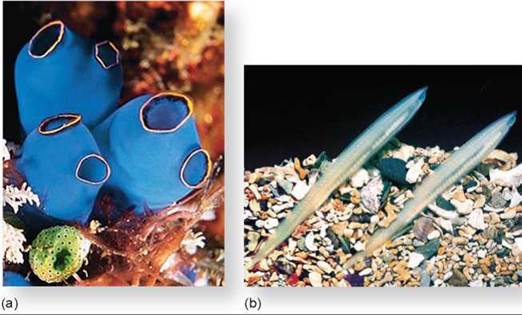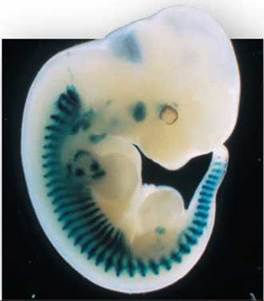THE LIVING WORLD
Unit Five. Evolution of Animal Life
19. Evolution of the Animal Phyla
19.13. Chordates: Improving the Skeleton
General Characteristics of Chordates
Chordates (phylum Chordata) are deuterostome coelomates whose nearest relations in the animal kingdom are the echinoderms, also deuterostomes.
Chordates exhibit great improvements in the en- doskeleton over what is seen in echinoderms. The endoskeleton of echinoderms is functionally similar to the exoskeleton of arthropods in that it is a hard shell that encases the body, with muscles attached to its inner surface. Chordates employ a very different kind of endoskeleton, one that is truly internal. Members of the phylum Chordata are characterized by a flexible rod called a notochord that develops along the back of the embryo. Muscles attached to this rod allowed early chordates to swing their bodies back and forth, swimming through the water. This key evolutionary innovation, attaching muscles to an internal element, started chordates along an evolutionary path that leads to the vertebrates and for the first time to truly large animals.
The approximately 56,000 species of chordates are distinguished by four principal features:
1. Notochord. A stiff, but flexible, rod that forms beneath the nerve cord in the early embryo (the yellow rod in the facing Phylum Facts illustration).
2. Nerve cord. A single, hollow, dorsal (along the back) nerve cord (the blue rod in the illustration), to which the nerves that reach the different parts of the body are attached.
3. Pharyngeal pouches. A series of pouches behind the mouth that develop into slits in some animals. The slits open into the pharynx, which is a muscular tube that connects the mouth to the digestive tract and windpipe (gill slits are labeled in the Phylum Facts illustration).
4. Postanal tail. Chordates have a postanal tail, a tail that extends beyond the anus. A postanal tail is present at least during their embryonic development if not in the adult. Nearly all other animals have a terminal anus.
All chordates have all four of these characteristics at some time in their lives. For example, the tunicates in figure 19.28a look more like sponges than chordates, but their larval stage, which resembles a tadpole, has all four features listed above. Human embryos have pharyngeal pouches, a nerve cord, a notochord, and a postanal tail as embryos. The nerve cord remains in the adult, differentiating into the brain and spinal cord. The pharyngeal pouches and postanal tail disappear during human development, and the notochord is replaced with the vertebral column. In their body plan, all chordates are segmented, and distinct blocks of muscles can be seen clearly in many forms (figure 19.29).

Figure 19.28. Nonvertebrate chordates.
(a) Beautiful blue and gold tunicates. (b) Two lancelets, Branchiostoma lanceolatum, partly buried in shell gravel, with their anterior ends protruding. The muscle segments are clearly visible in this photograph.

Figure 19.29. A mouse embryo.
At 11.5 days of development, the muscle is already divided into segments called somites (stained dark in this photo), reflecting the fundamentally segmented nature of all chordates.
Vertebrates
With the exception of tunicates (figure 19.28a) and lancelets (figure 19.28b), all chordates are vertebrates. Vertebrates differ from tunicates and lancelets in two important respects:
1. Backbone. The notochord becomes surrounded and then replaced during the course of the embryo’s development by a bony vertebral column, a stack of bones called vertebrae that encloses the dorsal nerve cord like a sleeve and protects it.
2. Head. All vertebrates except the earliest fishes have a distinct and well-differentiated head, with a skull and brain.
All vertebrates have an internal skeleton made of bone or cartilage against which the muscles work. This endoskel- eton makes possible the great size and extraordinary powers of movement that characterize the vertebrates.

Key Learning Outcome 19.13. Chordates have a notochord at some stage of their development. In adult vertebrates, the notochord is replaced by a backbone.
Inquiry & Analysis
Punctuated Equilibrium: Evaluating a Case History
Biologists have long argued over the rate at which evolution occurs. Some organisms appear to have evolved gradually (gradualism), while in others evolution seems to have occurred in spurts (punctuated equilibrium). There is evidence of both patterns in the fossil record. Perhaps the most famous claim of punctuated equilibrium has been made by researchers studying the fossil record of marine bryozoans. Bryozoans are microscopic aquatic animals that form branching colonies. You encountered them earlier in this chapter as lophophorates. The fossil record is particularly well documented for Caribbean bryozoan species of the genus Metrarabdotos, whose fossil record extends back more than 15 million years without interruption (a fossil is the mineralized stonelike remains of a long-dead organism; a fossil record is the total collection of fossils of that particular kind of organism known to science).
The graph to the upper right displays an analysis of the Metrarabdotos fossil record. Researchers first formulated a comprehensive character index based upon a broad array of bryozoan traits. (A character index is a number assigned to a specimen based on its morphology. Different characteristics are measured and assigned quantitative values, and the character index is determined by adding together the individual character values that apply to the specimen. The closer the character indices are for two specimens, the more closely related they are.) Then each fossil is measured for all of the traits. They then calculated the index number for that fossil and plotted it on the graph as a black dot. Each cluster of dots within an oval represents a distinct species.

1. Applying Concepts
a. Variable. In the diagram, is there a dependent variable? If so, what is it?
b. Analyzing Diagrams. How many different species are included in the study illustrated by this diagram? How many of these are extinct?
2. Interpreting Data
a. For each species, estimate how long that species survives in the fossil record. For simplicity, a species found only once should be assigned a duration of 1 million years. What is the average evolutionary duration of a Metrarabdotos species?
b. Create a histogram of your species-duration estimates (place the duration times on the x axis and the number of species on the y axis). What general statement can be made regarding the distribution of Metrarabdotos species durations?
3. Making Inferences
a. How many of the species exhibit variation in the comprehensive character index?
b. How does the magnitude of this variation within species compare with the variation seen between species?
4. Drawing Conclusions Does major evolutionary change, as measured by significant changes in this comprehensive character index, occur gradually or in occasional bursts?
5. Further Analysis Plot the number of Metrarabdotos species versus date (millions of years ago), in increments of 1 million years. Characterize the result. What do you suppose is responsible for this? How would you go about assessing this possibility?

Six species of fossil Metrarabdotos
1. The traditional organization of the animal family tree of classification is based mostly on
a. DNA sequences.
b. protein structure.
c. conserved anatomical characteristics.
d. ribosome structure.
2. Sponges possess unique, collared flagellated cells called
a. cnidocytes.
b. choanocytes.
c. choanoflagellates.
d. epithelial cells.
3. A characteristic that animals in the phylum Cnidaria share with fungi is
a. chitinous structural support.
b. sporulation.
c. extracellular digestion.
d. cnidocytes.
4. Which of the following characteristics is not seen in the phylum Platyhelminthes?
a. cephalization
b. the presence of a mesoderm
c. specialization of digestive tract
d. bilateral symmetry
5. One difference between the pseudocoel found in the phylum Nematoda (roundworms) and the coelom found in the phylum Annelida (segmented worms) is the pseudocoel develops between the mesoderm and the _____ in roundworms, and the coelom develops in the _____ in segmented worms.
a. ectoderm; mesoderm
b. endoderm; mesoderm
c. ectoderm; endoderm
d. endoderm; ectoderm
6. Unlike other coelomate animal phyla, mollusks lack
a. segmentation.
b. cephalization.
c. three primary tissue layers.
d. some type of body cavity.
7. Segmentation, first seen in annelids, allows evolutionary advantages by
a. allowing more fluid movement for less energy expense.
b. specialization of segments to carry out different functions.
c. allowing coelom development.
d. concentrating sensory and nervous tissues and organs in the direction of motion.
8. The main limiting factor of arthropod size is the
a. inefficiency of open circulatory systems.
b. weight of the muscles needed to move the organism.
c. weight of the thick exoskeleton needed to support very large insects.
d. weight of the entire organism, which if too great would crush the soft body of the arthropod during molting.
9. Echinoderms begin life as free-swimming larvae with bilateral symmetry and then become adults with radial symmetry. Some biologists explain this change in symmetry as an adaptation for
a. an animal traveling through the environment, rather than one having a sessile lifestyle.
b. an animal with a sessile lifestyle, rather than one that moves through the environment.
c. a predator, rather than a filter-feeder.
d. an animal living in a marine environment, rather than a freshwater environment.
10. Which of the following animals is not a chordate?
a. dogs
b. sea cucumbers
c. tunicates
d. lancelets